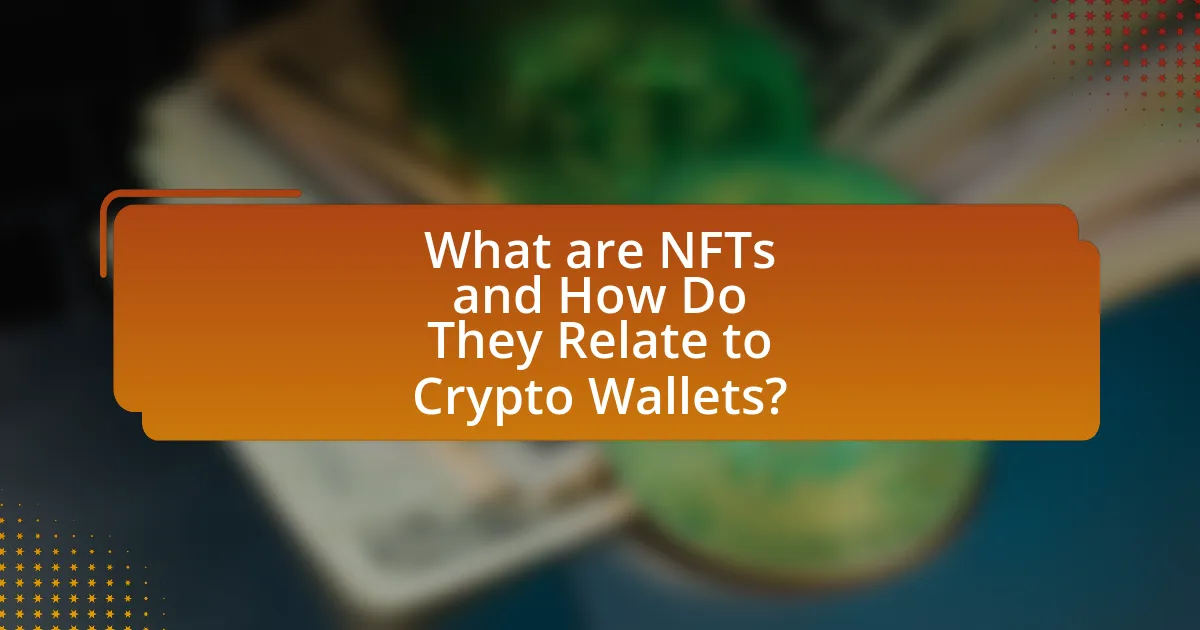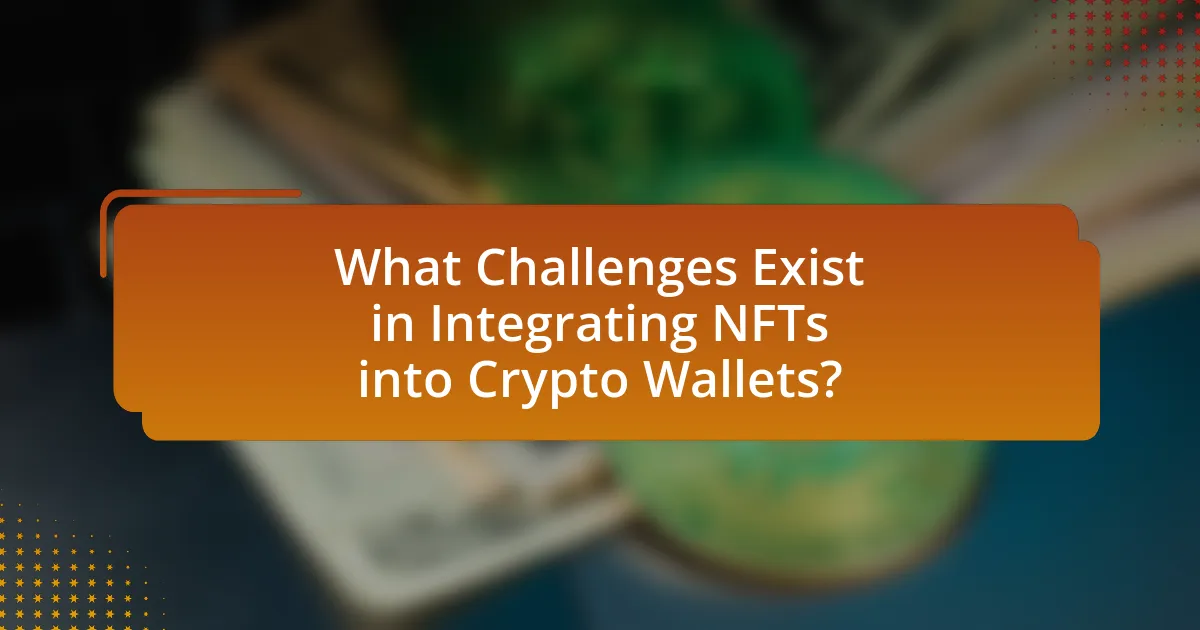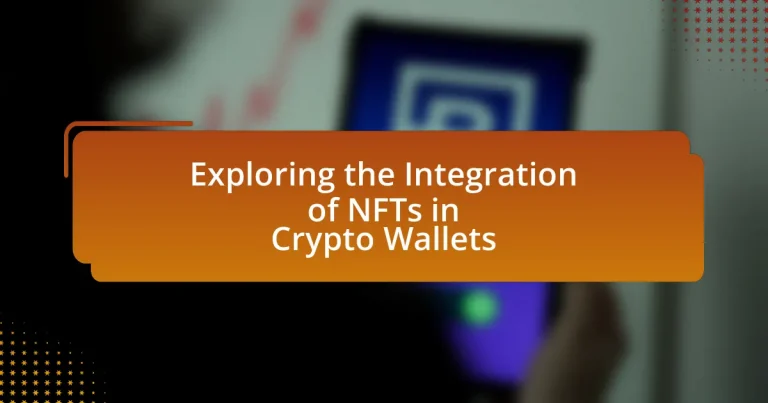NFTs, or Non-Fungible Tokens, are unique digital assets that signify ownership of specific items on a blockchain, primarily Ethereum. This article explores the critical relationship between NFTs and crypto wallets, which serve as secure storage solutions for managing these digital assets. Key topics include the definition and characteristics of NFTs, the functionality of crypto wallets in facilitating NFT transactions, the challenges of integrating NFTs into wallets, and future trends in the NFT market. Additionally, the article addresses security concerns, regulatory issues, and best practices for users to effectively manage their NFTs within crypto wallets.

What are NFTs and How Do They Relate to Crypto Wallets?
NFTs, or Non-Fungible Tokens, are unique digital assets that represent ownership of a specific item or piece of content on a blockchain, primarily Ethereum. They differ from cryptocurrencies like Bitcoin because each NFT has distinct characteristics and cannot be exchanged on a one-to-one basis. Crypto wallets are essential for storing, managing, and transacting NFTs, as they provide the necessary infrastructure to hold these tokens securely. Wallets can be either software-based or hardware-based, allowing users to interact with NFT marketplaces and transfer ownership of their digital assets. The relationship between NFTs and crypto wallets is crucial, as wallets enable users to access their NFTs, verify ownership through blockchain technology, and facilitate transactions in the growing NFT ecosystem.
What is the definition of NFTs?
NFTs, or Non-Fungible Tokens, are unique digital assets that represent ownership of a specific item or piece of content on a blockchain. Unlike cryptocurrencies such as Bitcoin or Ethereum, which are fungible and can be exchanged on a one-to-one basis, NFTs are distinct and cannot be exchanged on a like-for-like basis due to their unique properties. The proof of ownership and authenticity of NFTs is secured through blockchain technology, which provides a transparent and immutable record of transactions. This uniqueness and verifiable ownership make NFTs particularly valuable in digital art, collectibles, and various forms of digital media.
How do NFTs differ from traditional digital assets?
NFTs differ from traditional digital assets primarily in their uniqueness and ownership verification. While traditional digital assets, such as images or music files, can be easily replicated and shared without loss of quality, NFTs (Non-Fungible Tokens) are unique cryptographic tokens that represent ownership of a specific digital item on a blockchain. This uniqueness is enforced by the blockchain technology, which provides a transparent and immutable record of ownership, making it impossible to duplicate the NFT itself. For example, a digital artwork sold as an NFT can be verified as the original through its unique token ID, whereas a traditional digital copy can be freely copied and distributed without any proof of authenticity.
What are the key characteristics of NFTs?
The key characteristics of NFTs include uniqueness, indivisibility, ownership verification, and programmability. Uniqueness means each NFT has distinct information or attributes that set it apart from others, often represented through metadata on a blockchain. Indivisibility indicates that NFTs cannot be divided into smaller units; they exist as whole items. Ownership verification is facilitated by blockchain technology, which provides a transparent and immutable record of ownership, ensuring that the provenance of the NFT can be traced. Programmability allows NFTs to incorporate smart contracts, enabling automated actions based on predefined conditions, enhancing their functionality and potential use cases. These characteristics are foundational to the value and utility of NFTs in digital ecosystems.
How do crypto wallets function in the context of NFTs?
Crypto wallets function as secure storage solutions for non-fungible tokens (NFTs), allowing users to manage, buy, sell, and transfer these unique digital assets. Each NFT is represented by a unique token on a blockchain, and crypto wallets store the private keys necessary to access and control these tokens. For example, wallets like MetaMask and Trust Wallet support various NFT standards, such as ERC-721 and ERC-1155, enabling users to interact with NFT marketplaces and decentralized applications seamlessly. The integration of NFTs into crypto wallets enhances user experience by providing a centralized platform for asset management, ensuring that ownership and transaction history are verifiable on the blockchain.
What types of crypto wallets support NFTs?
Crypto wallets that support NFTs include custodial wallets, non-custodial wallets, and hardware wallets. Custodial wallets, such as those provided by exchanges, manage users’ private keys and allow for easy access to NFTs. Non-custodial wallets, like MetaMask and Trust Wallet, give users full control over their private keys and support various NFT standards. Hardware wallets, such as Ledger and Trezor, offer enhanced security for storing NFTs offline, protecting them from online threats. Each type of wallet provides unique features that cater to different user needs in managing NFTs.
How do users store and manage NFTs in crypto wallets?
Users store and manage NFTs in crypto wallets by utilizing wallet applications that support NFT standards, such as ERC-721 and ERC-1155. These wallets allow users to securely hold their NFTs, view their collections, and interact with decentralized applications (dApps) for buying, selling, or trading NFTs. For instance, popular wallets like MetaMask and Trust Wallet provide interfaces that display NFT ownership and metadata, enabling users to manage their digital assets effectively. Additionally, users can transfer NFTs between wallets using blockchain transactions, ensuring that ownership is recorded on the blockchain, which provides proof of authenticity and ownership.
Why is the integration of NFTs in crypto wallets important?
The integration of NFTs in crypto wallets is important because it enables users to securely store, manage, and trade their digital assets in a unified platform. This integration enhances user experience by simplifying access to NFTs alongside cryptocurrencies, facilitating seamless transactions and ownership verification. Additionally, as of 2023, the NFT market has grown significantly, with sales reaching over $25 billion in 2021, demonstrating the increasing demand for NFT management within crypto wallets. This trend underscores the necessity for wallets to support NFTs, ensuring users can efficiently engage with the evolving digital asset landscape.
What advantages does this integration provide to users?
The integration of NFTs in crypto wallets provides users with enhanced ownership and management of digital assets. This integration allows users to store, transfer, and showcase their NFTs alongside cryptocurrencies, streamlining the user experience. Additionally, it facilitates easier access to decentralized marketplaces, enabling users to buy, sell, or trade NFTs directly from their wallets. According to a report by NonFungible.com, the NFT market grew to over $10 billion in 2021, highlighting the increasing demand for efficient management solutions.
How does it enhance the overall user experience in the crypto space?
The integration of NFTs in crypto wallets enhances the overall user experience by providing seamless access to digital assets and simplifying management. Users can easily store, view, and trade NFTs alongside cryptocurrencies, creating a unified platform that reduces the complexity of handling multiple asset types. This integration fosters greater engagement, as users can showcase their NFTs and participate in decentralized applications directly from their wallets. According to a report by NonFungible.com, the NFT market saw a significant increase in user activity, with over 2.3 million active wallets in 2021, indicating that streamlined access to NFTs contributes to a more vibrant and interactive crypto ecosystem.

What Challenges Exist in Integrating NFTs into Crypto Wallets?
Integrating NFTs into crypto wallets presents several challenges, including technical compatibility, user experience, and security concerns. Technical compatibility issues arise because not all wallets support the various NFT standards, such as ERC-721 and ERC-1155, leading to fragmentation in the ecosystem. User experience challenges stem from the complexity of managing NFTs compared to traditional cryptocurrencies, which can deter less tech-savvy users. Security concerns are heightened due to the high value of NFTs, making them attractive targets for hackers, necessitating robust security measures to protect users’ assets. These challenges highlight the need for improved wallet solutions that can seamlessly integrate NFTs while ensuring user-friendly interfaces and enhanced security protocols.
What are the technical challenges of NFT integration?
The technical challenges of NFT integration include scalability, interoperability, and security. Scalability issues arise from the high transaction volumes on blockchain networks, which can lead to slow processing times and increased fees. Interoperability challenges occur when NFTs created on different platforms cannot easily interact or be transferred across various blockchain ecosystems. Security concerns involve the risk of smart contract vulnerabilities and the potential for hacks, which can compromise the ownership and authenticity of NFTs. These challenges are critical as they directly impact user experience and the overall adoption of NFTs in crypto wallets.
How do blockchain limitations affect NFT storage in wallets?
Blockchain limitations significantly affect NFT storage in wallets by imposing constraints on transaction speed, scalability, and data storage capacity. These limitations can lead to slower transaction times when users attempt to buy, sell, or transfer NFTs, as the blockchain may struggle to process a high volume of transactions simultaneously. For instance, Ethereum, a popular blockchain for NFTs, has faced congestion issues, resulting in delayed transactions and increased gas fees, which can deter users from engaging with NFTs. Additionally, the size of NFT metadata and associated files can exceed the storage capacity of the blockchain, necessitating off-chain solutions that may complicate wallet integration and accessibility. This reliance on external storage solutions can introduce risks related to data integrity and accessibility, ultimately impacting the user experience in managing NFTs within wallets.
What security concerns arise with NFT integration in wallets?
Security concerns with NFT integration in wallets include the risk of theft, loss of private keys, and smart contract vulnerabilities. The integration of NFTs can expose wallets to phishing attacks, where malicious actors impersonate legitimate platforms to steal credentials. Additionally, if users lose access to their private keys, they may permanently lose their NFTs, as there is no recovery mechanism. Furthermore, smart contracts governing NFTs can contain bugs or vulnerabilities that hackers can exploit, leading to unauthorized transfers or loss of assets. According to a report by Chainalysis, over $2.8 billion was lost to cryptocurrency hacks in 2021, highlighting the significant risks associated with digital asset management.
What regulatory issues impact NFT integration in crypto wallets?
Regulatory issues impacting NFT integration in crypto wallets primarily include compliance with anti-money laundering (AML) and know your customer (KYC) regulations. These regulations require wallet providers to verify the identities of users and monitor transactions to prevent illicit activities. For instance, the Financial Action Task Force (FATF) guidelines mandate that virtual asset service providers, including crypto wallets, implement measures to ensure compliance with these regulations. Additionally, intellectual property rights and taxation laws pose challenges, as the ownership and transfer of NFTs can complicate legal frameworks. The evolving nature of regulations in different jurisdictions further complicates the integration process, as companies must navigate varying legal requirements globally.
How do different jurisdictions approach NFT regulations?
Different jurisdictions approach NFT regulations with varying degrees of clarity and enforcement. For instance, the United States has a fragmented regulatory landscape where NFTs may be classified as securities under certain conditions, depending on their characteristics and the context of their sale, as outlined by the SEC’s guidance. In contrast, the European Union is working towards a comprehensive regulatory framework through the Markets in Crypto-Assets (MiCA) proposal, which aims to provide clear definitions and rules for digital assets, including NFTs. Meanwhile, countries like China have imposed strict bans on cryptocurrency transactions, which indirectly affects the NFT market by limiting its growth and adoption. These differences highlight the diverse regulatory environments that impact how NFTs are created, traded, and utilized across the globe.
What implications do these regulations have for wallet providers?
Regulations significantly impact wallet providers by imposing compliance requirements that affect their operational frameworks. These regulations often mandate Know Your Customer (KYC) and Anti-Money Laundering (AML) protocols, compelling wallet providers to implement robust identity verification processes. For instance, the Financial Action Task Force (FATF) guidelines require wallet providers to monitor transactions and report suspicious activities, which increases operational costs and complexity. Additionally, non-compliance can lead to severe penalties, including fines and restrictions on service offerings, thereby influencing the competitive landscape among wallet providers.

What Future Trends Can We Expect for NFTs in Crypto Wallets?
Future trends for NFTs in crypto wallets include enhanced interoperability, increased security measures, and the integration of social features. Interoperability will allow NFTs to be easily transferred and utilized across different blockchain platforms, facilitating broader use cases. Increased security measures, such as multi-signature wallets and biometric authentication, will protect users’ digital assets from theft and fraud. Additionally, the integration of social features will enable users to showcase their NFT collections within their wallets, fostering community engagement and interaction. These trends are supported by the growing demand for user-friendly and secure digital asset management solutions in the evolving crypto landscape.
How is the market for NFTs evolving?
The market for NFTs is evolving towards increased mainstream adoption and diversification of use cases. Recent data indicates that NFT sales reached approximately $25 billion in 2021, showcasing a significant rise from $100 million in 2020. This growth is driven by various sectors, including art, gaming, and virtual real estate, as brands and creators explore innovative applications of NFTs. Additionally, platforms are enhancing user experiences by integrating NFTs into crypto wallets, facilitating easier access and management for users. This integration is expected to further stimulate market growth and engagement.
What new use cases for NFTs are emerging?
New use cases for NFTs are emerging in areas such as digital identity verification, ticketing for events, and virtual real estate ownership. Digital identity verification utilizes NFTs to provide secure and verifiable identities, enhancing privacy and reducing fraud. In ticketing, NFTs are being used to create unique, tamper-proof tickets that can be easily transferred and verified, thus combating counterfeiting. Virtual real estate ownership involves the buying and selling of virtual land and properties in metaverse platforms, where NFTs represent ownership rights, enabling users to trade and develop digital assets. These applications demonstrate the versatility of NFTs beyond art and collectibles, indicating their growing significance in various sectors.
How are technological advancements shaping the future of NFTs in wallets?
Technological advancements are enhancing the functionality and security of NFTs in wallets by enabling seamless integration, improved user interfaces, and advanced security protocols. Innovations such as multi-signature wallets and biometric authentication are making it easier for users to manage their NFTs securely. Additionally, the development of cross-chain compatibility allows NFTs to be stored and transferred across different blockchain networks, increasing their accessibility and utility. For instance, platforms like Ethereum and Polygon are now interoperable, allowing users to manage NFTs from various ecosystems within a single wallet. These advancements not only streamline the user experience but also bolster the overall security of NFT transactions, making wallets more robust against potential threats.
What best practices should users follow when managing NFTs in wallets?
Users should follow several best practices when managing NFTs in wallets to ensure security and proper organization. First, users must utilize hardware wallets for enhanced security, as these devices store private keys offline, reducing the risk of hacks. Additionally, users should regularly back up their wallet information, including seed phrases and private keys, to prevent loss due to device failure or accidental deletion.
Moreover, users should enable two-factor authentication (2FA) on their wallets to add an extra layer of security against unauthorized access. It is also crucial for users to verify the authenticity of NFTs before purchase, as counterfeit NFTs can lead to financial loss. Lastly, users should keep their wallet software updated to protect against vulnerabilities and ensure compatibility with the latest NFT standards. These practices collectively help safeguard users’ digital assets and enhance their overall experience in managing NFTs.
How can users ensure the security of their NFTs in crypto wallets?
Users can ensure the security of their NFTs in crypto wallets by employing strong passwords, enabling two-factor authentication, and using hardware wallets. Strong passwords protect against unauthorized access, while two-factor authentication adds an extra layer of security by requiring a second form of verification. Hardware wallets, which store private keys offline, significantly reduce the risk of hacking and phishing attacks, as they are less vulnerable to online threats. According to a report by Chainalysis, hardware wallets are considered one of the safest methods for storing cryptocurrencies and NFTs due to their offline nature, which minimizes exposure to cyber threats.
What tips can enhance the management of NFTs within wallets?
To enhance the management of NFTs within wallets, users should prioritize organization by categorizing NFTs based on attributes such as type, value, or project. This method allows for easier navigation and quicker access to specific assets. Additionally, utilizing wallet features like tagging or custom labels can further streamline the management process. Regularly updating wallet software ensures compatibility with the latest NFT standards and security protocols, reducing the risk of loss or theft. Furthermore, backing up wallet data securely is crucial, as it protects against accidental loss and facilitates recovery. These practices are supported by the growing complexity of NFT ecosystems, which necessitate efficient management strategies for optimal user experience.


